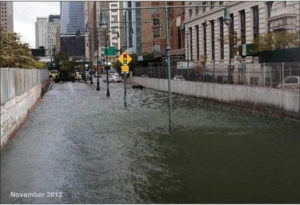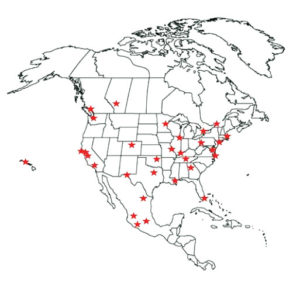In 2016, many organizations launched resiliency initiatives making “resilience” the new buzzword. In the building and infrastructure industry, resilience is defined in many ways. In 2014, the ASCE/SEI Sustainability Committee defined resilience as the ability to suffer less damage and recover more quickly from adverse events. These adverse events are not only external shocks in the form of natural or man-made disasters (hurricanes, floods, earthquakes, etc.), but also economic, social, political, and cultural adverse events that could damage the framework of a community. Today, this also includes the effects of climate change and the resulting rapid increase in the frequency of external shocks.
President Barack Obama has made resilience a priority in the past year with two events hosted at the White House. The White House Summit on Earthquake Early Warning Systems was a full-day publically broadcast event that discussed the benefits of earthquake early warning systems on hazard mitigation and disaster resilience. The second event was the White House Conference on Resilient Building Codes. This event included the Obama administration announcing public and private sector efforts to increase community resilience through building codes.
LEED offers three resilience pilot credits for project teams that plan and design for potential disasters in the project area. This includes pre-planning and site investigation, designing to resist the potential disasters, and designing a structure to be habitable after the disaster. These credits shift disaster resilience from disaster recovery to disaster risk mitigation.
States and cities are developing resilience plans to assess their current infrastructure and prioritize future planning. In 2014, New York City developed OneNYC, a resilience plan that addresses flood mitigation along New York City’s 520 miles of coastline. Figure 1 shows the Battery Park Underpass in New York City after Hurricane Sandy. Motivated by the extreme effects of Hurricane Sandy in 2012, this plan also addresses how to mitigate flooding for the 400,000 residents of New York City that live in a 100-year floodplain. The City of Boston has also addressed the effect of sea level rise. A Climate Change Adaptation Plan was developed by the city and includes flood hazard maps that account for sea level rise, and climate preparedness and community engagement. In 2014, the city of New Orleans also developed a resilience strategy. This plan addresses flood mitigation through the use of innovative methodologies such as parks and green streets to protect the city’s population and economy. Both New York City and New Orleans received grant money from the HUD National Disaster Resilience Competition to implement many of their resilience strategies. These will have direct implications on the work that civil and structural engineers are performing in the regions. Other areas of the country have also developed resiliency plans, including the city of San Francisco and the states of Washington and Oregon.
How will these initiatives affect structural engineers, their jobs, and their projects? The Disaster Resilience Working Group of the ASCE/SEI Sustainability Committee has researched some of the organizations within the building construction community that are addressing resilience. This article identifies these organizations, along with their resilience goals and how these goals will affect structural engineers.
Legislation
Cities within the state of California have been actively working to increase their seismic resilience. Wiss, Janney, Elstner Associates, Inc. (WJE) developed a website to track seismic ordinances within California. This website provides upgrade requirements and relevant deadlines. In April 2013, the city of San Francisco adopted an ordinance that required the mandatory seismic retrofit of wood-frame soft-story buildings (buildings with a weaker first floor that are prone to collapse in an earthquake). As a result of this ordinance, around 4300 buildings were surveyed and 2800 were identified by engineers to have a soft story. All of the affected building owners were notified in September 2013 and required to have submitted forms demonstrating that their building was evaluated by a licensed professional engineer by September 2014. There was a 99% compliance with this step of the ordinance. Those building owners that did not comply had their building placarded with a Notice of Violation. The next phase of the ordinance, for those buildings affected, is to submit a permit application with plans for a seismic retrofit. Once the permit application is submitted, the building owner has one year to complete the retrofit. All retrofits must be completed by 2020.
In October 2015, the city of Los Angeles adopted an ordinance that requires the mandatory seismic retrofit of wood-frame soft-first-story buildings, similar to the ordinance in San Francisco, and an ordinance that requires the retrofit of nonductile concrete buildings. These ordinances affect over 15,000 buildings.
The cities of Portland and Seattle have developed interactive maps to locate all of their unreinforced masonry buildings (URM). Both cities are currently working on developing legislation for URM ordinances mandating retrofits of URM buildings.
The City of New York has prepared a Climate Change Adaptation Task Force that has developed climate predictions for New York City through 2100. The City has also produced a document, Retrofitting Buildings for Flood Risk (NYC Planning, 2014), and updated the New York City Building Code to include increased risk of flooding.
Organizations Promoting Resilience
Resilience can be addressed at different scales: on an individual building basis or a community basis. The following section describes organizations and tools addressing building resilience and community resilience.
The Rockefeller Foundation
100 Resilient Cities is a program developed by the Rockefeller Foundation. This initiative is challenging cities around the world to make resilience a priority. 100 Resilient Cities not only considers the progress cities have made to decrease the long-term impacts of external shocks (hurricanes, earthquakes, floods, etc.), but also the day-to-day stresses a city experiences on its social, economic, cultural, and political framework. Cities are required to apply for the distinction by developing a resilience strategy or plan. Those cities chosen to be part of the 100 Resilient Cities receive monetary and logistical support to establish a Resilience Officer for the city. Figure 2 shows the locations of the 100 Resilient City participants in North America.
NIST Community Resilience Program
NIST addresses natural and man-made disasters having catastrophic impacts on the building stock of a community (NIST, 2015). Today’s communities are constructed with many interdependencies within the built environment. Previous earthquakes have demonstrated that buildings in a community can have an effect on functionality after an earthquake. There is a potential that, if one building is not functional, there is a global impact to the community’s ability to operate after a disaster. NIST has developed a program that allows communities to examine the vulnerabilities in the interdependencies of the built environment.
Resilient Design Institute (RDI)
The Resilient Design Institute is a web-based application that hosts case studies, strategies, and principles of resilient design. The website aims to be a resource for individuals, organizations, and communities that would like to incorporate hazard mitigation and resilience into their designs. This website addresses both man-made and natural disasters. RDI also provides consulting services for project teams.
FEMA P-58
FEMA P-58: Seismic Performance Assessment of Buildings (FEMA, 2012) is a document based on a 10-year FEMA study which provides a performance prediction based on building-specific analysis. The results from a FEMA P-58 analysis are Losses (in dollars), Fatalities & Injuries, Repair Time & Tagging, and Environmental Impacts. The methodology involves a probabilistic approach using a Monte Carlo simulation. Probabilistic variables including ground motions, structural responses, content damage fragility curves, and loss curves are run through various simulations to provide confidence levels for certain outcomes. The Performance Assessment Calculation Tool (PACT) is the companion software to FEMA P-58.
USRC Rating System
The United States Resiliency Council is a non-profit organization which implements a rating system for the earthquake performance of buildings. It aims to provide a universal rating system akin to LEED ratings for sustainability. As of now, the rating system is limited to earthquakes, but the goal of the council is to expand the rating systems into additional disasters in the future. The city of Los Angeles has already adopted this rating system to improve the performance of its buildings.
Arup REDi
Arup’s Resilience-Based Earthquake Design Initiative (REDi) is both a framework for designing resilient buildings as well as a rating system which qualifies the level of resilience. This rating system focuses on planning for three different levels of resilience: Building Resilience (structural system), Organizational Resilience (disaster planning), and Ambient Resilience (adjacent buildings and other site hazards). The REDi rating system also requires a loss assessment using PACT.
REDi ratings are classified as Platinum, Gold, and Silver. The building must be shown to meet certain performance objectives for Downtime, Direct Financial Loss, and Occupant Safety to meet any of the ratings.
SP3
The Seismic Performance Prediction Program (SP3) is an online, cloud-based tool developed by Haselton Baker Risk Group. It serves as an interface to use the FEMA P-58 methodology and can also calculate probable maximum loss (PML), an Arup REDi rating, and a USRC rating. The tool provides a more streamlined way to implement the FEMA P-58 methodology by providing soil and hazard curves and content estimates pre-packaged in the tool.
EA Tool
The Environment Assessment Tool™ (EA Tool) is a life cycle analysis tool developed by Skidmore, Owings & Merrill LLP to estimate the equivalent carbon emissions of a structure. Calculated embodied carbon quantities consider contributions from materials and construction including material extraction, transportation, construction waste, and equipment operations. Furthermore, the tool provides a link between sustainability and resilience by estimating the embodied carbon associated with repairs related to seismic damage and the potential for full demolition and replacement of a severely damaged structure. Probable seismic damage is based on HAZUS fragility curves and can account for increased performance for enhanced seismic systems. The EA Tool is intended to be used by architects, engineers and building owners to help inform early design decisions and provide a cost-benefit analysis of enhanced seismic systems.
Resilience Insight Tool
BuroHappold’s Resilience Insight Tool is an online tool that evaluates the resilience of an entire city. It provides a framework to assess a city’s capability against different shocks/stresses including natural hazards, epidemics, and attacks. Based on a series of inputs, the tool provides an assessment of the vulnerability and adaptive capacity of a city in terms of the effects on Society & Community, Governance & Economy, and Environment & Infrastructure (BuroHappold, 2016).
U.S. Climate Resiliency Toolkit
The U.S. Climate Resilience Toolkit (NOAA, 2016) provides multiple scientific tools and information to assist people and entities that would like to manage their climate-related risks and improve their resilience to extreme events. This site is developed for citizens, communities, businesses, city planners, and policy advocates. The site includes many different modules: a five-step process to plan, initiate, and manage a project that is resilient to climate-related events; real-world case studies that have been successfully implemented by communities and businesses; climate data organized in maps, interactive tools, charts, and more; and federally-developed training programs. The U.S. Climate Resilience Toolkit was developed in response to President Barack Obama’s Climate Action Plan and Executive Order to help the nation prepare for climate-related changes and impacts.
Conclusions
Modern-day cities are approaching disaster mitigation from a holistic perspective that includes the performance of the built environment during a natural or man-made disaster. Cities and regions are assessing their infrastructure for long-term resilience. These assessments and recommendations can have an impact on the extreme loading demands structural engineers use to evaluate buildings, in addition to the priorities of a region. For example, the cities of Boston, New York, and New Orleans have updated coastal flooding hazard maps to incorporate the effects of climate change and sea level rise. The City of New York has updated the New York City Building Code to incorporate these changes. The tools presented in this article aim to help engineers design for long-term resilience in a manner consistent with city, state, and countries resilient plans.
The organizations and toolkits discussed within this article each present different approaches to resilience, and allow structural engineers to be a part of the movement. This is by no means a comprehensive list of organizations and tools. It is critical to remember that resilience is not only applicable to seismic hazards. In fact, the LEED sustainability metric has expanded its resilience pilot credits to include floods, hurricanes, and wildfires. The northeastern U.S. is still recovering from Hurricane Sandy. Building owners are considering the future impacts of climate change and natural disasters on their buildings. Most recently, the Whitney Museum of Art building in southern Manhattan was constructed considering flooding due to storm surge.
As structural engineers, we have a responsibility to help protect cities from a variety of disasters and aim to continually improve our communities. As natural disasters become more frequent and larger in magnitude, cities observe the capacity of their infrastructure and their ability to recover first-hand. In the U.S., every dollar spent on pre-disaster hazard mitigation results in four dollars in future benefits for a community (ASCE/SEI Sustainability Committee, 2014). In the past ten years, the damage due to increasing amounts of rainfall and increasing temperature around the world has totaled over US$1.4 trillion (Michell, 2016). Natural disasters and the effects of climate change are causing large economic burdens for cities around the world.
Cities within the U.S. are developing resilience strategies for pre-disaster mitigation to take advantage of that statistic, and reduce post-disaster recovery costs and the effects of the disasters in their communities. These resilience strategies will have a direct impact on structural engineers’ work and the direction of the building codes.▪
References
Arup. (2013). REDi Rating System: Resilience-based earthquake engineering design initiative for next-generation buildings. Arup.
BuroHappold. (2016). BuroHappold’s Resilience Tool User Guide. BurroHappold Engineering.
City of New Orleans. (2015). Resilient New Orleans: Strategic actions to shape our future city. City of New Orleans: New Orleans, LA.
City of San Francisco. (2013). Building Code – Mandatory Seismic Retrofit Program – Wood-Frame Buildings, Ordinance No. 183893. City of San Francisco: San Francisco, CA.
City of Los Angeles. (2015). Mandatory Earthquake Hazard Reduction in Existing Wood-Frame Buildings with Soft, Weak, or Open Front Walls, Ordinance No. 66-13. City of Los Angeles: Los Angeles, CA.
Comber, M.V., Poland, C., Sinclair, M. (2012). “Environmental Impact Assessment: Application of Performance-Based Earthquake Engineering Methodologies to Optimize Environmental Performance.” Proceedings, American Society of Civil Engineers (ASCE)/Structural Engineering Institute (SEI) Structures Congress, Chicago, IL.
Comber, M.V., Poland, C. (2013). “Disaster Resilience and Sustainable Design: Quantifying the Benefits of a Holistic Design Approach.” Proceedings, American Society of Civil Engineers (ASCE)/Structural Engineering Institute (SEI) Structures Congress, Pittsburgh, PA.
Comber, M.V., Poland, C., Sinclair, M. (2013). “Sustainable Concrete Structures through Seismic Resilience: A Case Study.” Proceedings, International Concrete Sustainability Conference, San Francisco, CA.
COP21. (2015). Retrieved from Conference of Parties: cop21.gouv.fr
FEMA. (2012). Seismic Performance Assessment of Buildings. Federal Emergency Management Agency (FEMA): Washington, D.C.
GFDRR. (2016). Retrieved from ThinkHazard!: http://thinkhazard.org
Haselton Baker Risk Group. (2016). Seismic Performance Prediction Program (SP3) User Guide. Chico, CA
New York City Planning. (2014). Coastal Climate Resilience Retrofitting Buildings for Flood Risk. Department of City Planning of New York: New York, NY.
Michell, N. (2016). Economic losses can be countered by more resilient cities. Cities Today: London, UK.
NIST. (2015). Community Resilience Planning Guide for Buildings and Infrastructure Systems. National Institute of Standards and Technology (NIST): Gaithersburg, MD.
NOAA. (2016). Retrieved from U.S. Climate Resiliency Toolkit: http://toolkit.climate.gov
RDI. (2012). Retrieved from Resilient Design Institute: http://resilientdesign.org
Rockefeller Foundation. (2016). Retrieved from 100 Resilient Cities: www.100resilientcities.org
SOM. (2016). Retrieved from Skidmore, Owings & Merril LLP: https://somhpd.com/eatool
The City of New York. (2014). One New York: The Plan for a Strong and Just City. The City of New York: New York, NY.
USRC. (2016). Retrieved from U.S. Resilience Council: www.usrc.org/building-rating-system



